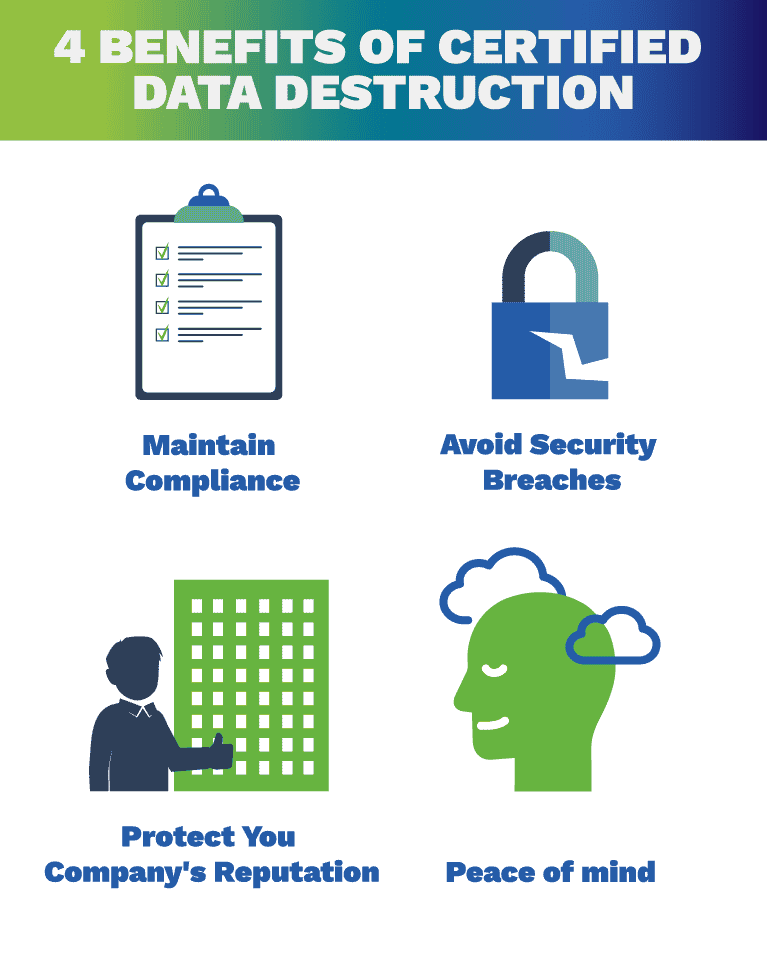The Value of Effective Data Devastation Practices in Safeguarding Sensitive Info and Ensuring Computer Safety And Security
In a period where information breaches are progressively typical, the significance of efficient data damage practices can not be overemphasized. Carrying out robust data destruction approaches not only reduces these threats however additionally lines up with legal conformity demands, ensuring that companies promote their online reputation and foster customer trust.
Comprehending Information Devastation
Recognizing information destruction is essential in today's electronic landscape, where sensitive info can quickly be jeopardized. Effective data destruction involves not merely ensuring but erasing files that information is irretrievable via detailed methods. This procedure is crucial for companies that handle confidential customer details, copyright, or inner records, as any type of violation can lead to extreme economic and reputational effects.
Data devastation includes various strategies, including shredding physical media, degaussing magnetic storage space gadgets, and using software-based services that overwrite information several times. Each method serves a specific function and has to straighten with the sensitivity of the info being disposed of. For example, physical devastation is frequently preferred for difficult drives consisting of highly confidential data, while software program techniques might suffice for much less sensitive information.
Additionally, adhering to sector criteria and regulations, such as the General Data Security Guideline (GDPR) or the Wellness Insurance Coverage Transportability and Accountability Act (HIPAA), is vital for compliance and to minimize lawful threats. Organizations must establish a durable information devastation plan, train employees on finest methods, and frequently audit their procedures to guarantee that all sensitive details is dealt with safely and successfully.
Dangers of Inadequate Practices
Inadequate information devastation practices expose organizations to substantial risks that can have far-reaching consequences. When sensitive information is not appropriately gotten rid of, it continues to be prone to unapproved access, which can bring about data breaches and identity theft. Such occurrences not just compromise the safety and security of individuals but likewise tarnish the company's track record, resulting in a loss of consumer depend on and potential monetary repercussions.
Additionally, regulatory conformity is increasingly strict in lots of industries. Failure to abide by data devastation guidelines can lead to large penalties and legal actions against organizations. These charges can divert and stress economic sources focus from core service procedures.
In addition, the misuse of residual information can cause copyright theft or company espionage, endangering affordable benefits (data destruction). The influence of poor information devastation expands past immediate monetary losses; it can also result in lasting damage to brand stability and market position

Organizations should recognize that information protection is not solely about preventing breaches; it likewise encompasses the responsible administration of data throughout its lifecycle. Disregarding reliable data damage procedures can have catastrophic ramifications, emphasizing the need for robust actions to minimize these threats.
Best Practices for Data Devastation
Carrying out efficient information damage methods is important for safeguarding sensitive info and preserving compliance with governing requirements. Organizations ought to embrace a multi-faceted approach to guarantee that information is irretrievable, consequently protecting against unapproved gain access to and potential violations.
First, data ought to be classified based upon level of sensitivity, allowing companies to use suitable destruction methods tailored to the degree of threat. For electronic data, making use of software-based data-wiping tools that conform with industry standards can successfully overwrite existing data. Physical destruction techniques, such as shredding or degaussing, are vital for tools that save sensitive details, guaranteeing full elimination.
Developing a clear information retention plan is essential, describing how much time different kinds of details must be preserved before destruction. Routine audits of information storage space systems are additionally necessary to recognize out-of-date or unneeded data requiring elimination.
Additionally, training workers on the importance of information destruction and the specific procedures to follow fosters a society of safety within the organization. Maintaining paperwork of data destruction refines provides responsibility and sustains compliance with interior policies and external laws. By adhering to these best techniques, organizations can considerably mitigate the dangers related to information direct exposure.
Legal and Conformity Considerations

Failure to follow these policies can lead to extreme penalties, consisting of significant fines and reputational damage. Organizations needs to implement a robust information destruction policy that aligns with these legal structures and gives clear standards on the appropriate approaches of data disposal, whether physical shredding or digital wiping.
In addition, maintaining documentation of data damage tasks is important for showing conformity during audits or assessments. By focusing on lawful and conformity factors to consider, organizations can enhance their data safety and security pose and foster trust fund with stakeholders and customers, inevitably adding to a much more safe information monitoring setting.
Benefits of Effective Information Damage
Reliable information destruction methods prolong beyond mere compliance; they offer significant advantages to organizations that prioritize them. By guaranteeing that sensitive information is irretrievably ruined, organizations minimize the threat of information breaches and the potential financial consequences connected with them. This aggressive technique not only safeguards versus unapproved accessibility however additionally enhances the overall trustworthiness of the company in the eyes of stakeholders and clients.
Executing robust try here information devastation techniques, such as physical destruction of storage space tools or sophisticated data cleaning strategies, adds to the conditioning of an organization's cybersecurity stance. data destruction. It minimizes the probability of intellectual residential or commercial property theft and shields exclusive info, thus preserving an affordable edge on the market
Verdict
To conclude, reliable data destruction methods are crucial for protecting delicate info and enhancing total computer protection. By carrying out thorough techniques such as degaussing, shredding, and software overwriting, companies can minimize the threats related to unauthorized access and data violations. Adherence to regulatory requirements, including GDPR and HIPAA, further reinforces compliance and protects versus legal consequences. Eventually, a commitment to robust data devastation strategies cultivates a society of duty, therefore enhancing an organization's cybersecurity stance and preserving client trust.